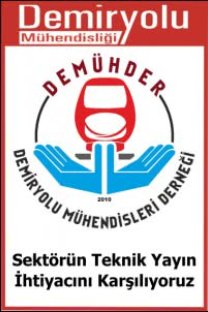Lokomotif Çekerleri Hesaplama Yöntemi
Bu çalışmada genel olarak demiryolu hatlarında trene etki eden dinamik kuvvetler anlatılmıştır. Trenlerin seyir dirençleri lokomotif ve vagonlar olmak üzere iki ana faktör üzerinde incelenerek demiryollarında kullanılan formüllerden bahsedilmiştir. Aynı şekilde hat üzerinden gelen kurp ve rampa dirençlerinin trenler üzerinde etkisini gösteren Uluslararası formüllerden bahsedilmiştir. Daha sonra, trene etki eden dirençlerin yenilebilmesi için gerekli olan tekerlek kuvvetinin nasıl hesaplanacağına değinilmiştir. Tüm bu dirençler anlatıldıktan sonra lokomotifin çekebileceği yükün nasıl hesaplanacağı anlatılarak bazı firmaların hesapladığı lokomotif çekerlerinin karşılaştırılması yapılarak hangi formüllerin kullanılmasının faydalı olacağı değerlendirilmiştir.
Locomotive Tractive Calculation Method
In this study, dynamic forces that affect train on railway lines are explained in general. running resistances of trains are analysed on two factors as locomotive and wagons and the formulas used in developed countries for railways are mentioned. Likewise, international formulas that show the effect of the curve and ramp resistances coming from the line on trains are mentioned. Later on, mentioned on how to calculate the needed wheel force to overcome the resistances that affect the train. After all these resistances are explained, the calculation of tractive force of the locomotive is clarified and it is explained that which formulas would be beneficial by comparing locomotive tractions in some companies.
Keywords:
Train Resistance, Running Resistance, Locomotive Haulage,
___
[1] Tren Dinamiği ve Tekerlek Kuvvetleri. Ankara, Turkey: Megep Yayınları, 2014.[2] E. Schmidt, Freight train resistance: its relation to car weight. University of Illinois: Engineering Experiment Station, vol. 31, no. 48, 1910.
[3] E. C. Schmidt, F. W. Marquis, The effects of cold weather upon train resistance and tonnage rating. University of Illinois: Engineering Experiment Station, vol. 59. no. 25, 1912.
[4] E. Schmidt, Freight train curve resistance on a one-degree curve and on a three-degree curve. University of Illinois: Engineering Experiment Station, vol. no. 45, 1927.
[5] Ö. Akbayır, F. H. Çakır, “Enerji verimliliği için tren direnci formüllerinin karşılaştırılması,” Mehmet Akif Ersoy Üniversitesi Fen Bilimleri Enstitüsü Dergisi, vol. 8, no. 1, pp. 112-126, 2017.
[6] W. J. Davis, The tractive resistance of electric locomotives and cars. Schenectady. N.Y.: General Electric, 1926.
[7] C. Urlu, Demiryolu araçlarının ileri dinamiği. Ankara, Turkey: TCDD Yayınları, 1999.
[8] G. Strahl, “Verfahren zur bestimmung der belastungsgrenzen der dampflokomotiven,” Z. Des. Vereins Dtsch. Ing. vol. 57, pp. 251, 1913.
[9] S.Y. Sapronova, V.P. Tkachenko, O.V. Fomin, I.I. Kulbovskiy E.P. Zub, Rail vehicles: the resistance to the movement and the controllability. Duit state university of infrastructure and technology, 2017.
- ISSN: 2149-1607
- Yayın Aralığı: Yılda 2 Sayı
- Başlangıç: 2014
- Yayıncı: Demiryolu Mühendisleri Derneği
Sayıdaki Diğer Makaleler
Demiryolu Balastının ve Özelliklerinin Araştırılması
Raylı Sistemlerde Kullanılacak Depolama Aygıtı Ödünleşim Seçimi ve Yatırım Kararı
Yeni Nesil Demiryolu Traversleri ve Yerli FRP Donatı Kullanımının Deneysel Araştırması
Sezgin ÖZDEMİR, Ömer SACAR, Evrencan ÖZCAN
Ömür AKBAYIR, Beytullah BAŞEĞMEZ
Ray Pedi ve Travers Altı Pedlerin Hat Bileşenleri ve Hat Performansı Üzerindeki Etkileri
Nehir Akımlarının Derin Öğrenme ile Tahmini ve Akımların Demiryolları Güzergahına etkisi
Demiryollarında Ön Germeli Traverslerin Farklı İşletme Yükleri Altında Mekanik Analizi
